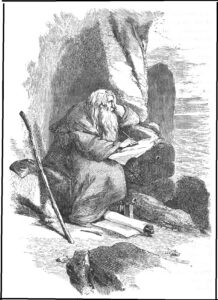The review of Christ’s Second coming: (1:7-8):
The book of Revelation is the ultimate action thriller. Anyone who loves a great novel will certainly love this book. Revelation is a book of great drama, horror but also of hope and joy. It culminates with a happy ending as sin and death are banished forever.
- Behold He is coming: (1:7a): Despite the scoffers who deny the second coming (2 Pet.3:3-4), Jesus repeatedly spoke of His coming. The return of Jesus Christ is the central theme in scriptures.
The hope that Christ will one day return and take believers to heaven to live forever in His presence provides hope and comfort for those who know Him. (Jn.14:1-3, 1 Thess. 4:17-18).
- The glory of His Coming: (1:7b): Clouds in scriptures frequently symbolize God’s presence. A cloud was used as the visible manifestation of God’s presence with Israel in the wilderness (Ex.13:21-22). At Mount Sinai, a thick cloud upon the mountain symbolized God’s presence (Ex.19:16). Believers will ascend with clouds at the time of rapture (1 Thess.4:17) and Christ will return with clouds (Matt.24:30, Acts. 1:11).
- He is coming certainly: (1:8): God calls Himself “the Alpha and the Omega,” emphasizing that He exists in all the tenses and all the times. He is not confined by time or space. He will come and settles the issue. The “Almighty” affirms His perfect power. Nothing can stop Him from carrying out His will.
- Jesus came the first time in humiliation. He will return in exaltation.
- He came the first time to serve. He will return to be served.
- He came the first time as the suffering servant. Her will return as the conquering King.
The Patmos Vision:(1:9-20)
The location of the dramatic revelation of Christ recorded in this book was the island of Patmos, a small island in the Aegean Sea southwest of Ephesus and between Asia Minor and Greece. Patmos island is a barren and volcanic island in the Aegean Sea. It is about 10-miles long and 6-miles wide, located 40-miles offshore from modern-day Turkey. According to several early church fathers (Irenaeus, Clement of Alexandria, and Eusebius), John was sent to this island as a prisoner following his effective pastorate at Ephesus by Emperor Domitian. Victorinus, the first commentator on the Book of Revelation, stated that John worked as a prisoner in the mines on this small island. Exhausting labour under the watchful eye of a Roman guard, insufficient food and clothing and having to sleep on the bare ground would have taken their toll on 90-year old man. It was on that bleak, barren island, under those brutal conditions, that John received the most extensive revelation of the future ever given. When the Emperor Domitian died in A.D. 96, his successor Emperor Nervalet released John to return to Ephesus. During John’s bleak days at Patmos, God gave him the tremendous revelation embodied in this final book of the Bible. John’s revelation occurred on the Lord’s Day while he was in the Spirit. Some have indicated that “the Lord’s Day” refers to the first day of the week. In the 2nd century, this phrase was widely used to refer Sunday because Christ’s resurrection took place on that day. Others say: it is the Lordy day which is a day chosen in a year when all the people under Roman kingdom would worship emperor Domitian calling him lord and god.
Hearing a loud voice like a trumpet, John was instructed to write on a scroll what he saw and heard and send it to seven churches located in Asia Minor. This is the first of 12 commands in this book for John to write what he saw, a command which seems related to each preceding vision. One vision, however, was not to be recorded (10:4). Each of these churches was an autonomous local church and the order of mention is geographical in a half-moon circle beginning at Ephesus on the coast, proceeding north to Smyrna and Pergamum, then swinging east and south to Thyatira, Sardis, Philadelphia, and Laodicea.
